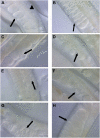Identification of mutations that delay somatic or reproductive aging of Caenorhabditis elegans
- PMID: 21750263
- PMCID: PMC3176124
- DOI: 10.1534/genetics.111.130450
Identification of mutations that delay somatic or reproductive aging of Caenorhabditis elegans
Abstract
Aging is an important feature of animal biology characterized by progressive, degenerative changes in somatic and reproductive tissues. The rate of age-related degeneration is genetically controlled, since genes that influence lifespan have been identified. However, little is known about genes that affect reproductive aging or aging of specific somatic tissues. To identify genes that are important for controlling these degenerative changes, we used chemical mutagenesis to perform forward genetic screens in Caenorhabditis elegans. By conducting a screen focused on somatic aging, we identified mutant hermaphrodites that displayed extended periods of pharyngeal pumping, body movement, or survival. One of these mutations is a novel allele of the age-1 gene. age-1 encodes a phosphatidylinositol-3-kinase (PI3K) that functions in the insulin/insulin-like growth factor-1 (IGF-1) signaling pathway. age-1(am88) creates a missense change in the conserved PIK domain and causes dramatic extensions of the pharyngeal pumping and body movement spans, as well as a twofold extension of the lifespan. By conducting screens focused on reproductive aging in mated hermaphrodites, we identified mutants that displayed increased progeny production late in life. To characterize these mutations, we developed quantitative measurements of age-related morphological changes in the gonad. The am117 mutation delayed age-related declines in progeny production and morphological changes in the gonad. These studies provide new insights into the genetic regulation of age-related degenerative changes in somatic and reproductive tissues.
Figures






References
-
- Apfeld J., Kenyon C., 1999. Regulation of lifespan by sensory perception in Caenorhabditis elegans. Nature 402: 804–809 - PubMed
-
- Ayyadevara S., Alla R., Thaden J. J., Shmookler Reis R. J., 2008. Remarkable longevity and stress resistance of nematode PI3K-null mutants. Aging Cell 7: 13–22 - PubMed
-
- Bolanowski M. A., Russell R. L., Jacobson L. A., 1981. Quantitative measures of aging in the nematode Caenorhabditis elegans. I. Population and longitudinal studies of two behavioral parameters. Mech. Ageing Dev. 15: 279–295 - PubMed
Publication types
MeSH terms
Substances
Grants and funding
LinkOut - more resources
Full Text Sources
Medical
Miscellaneous

